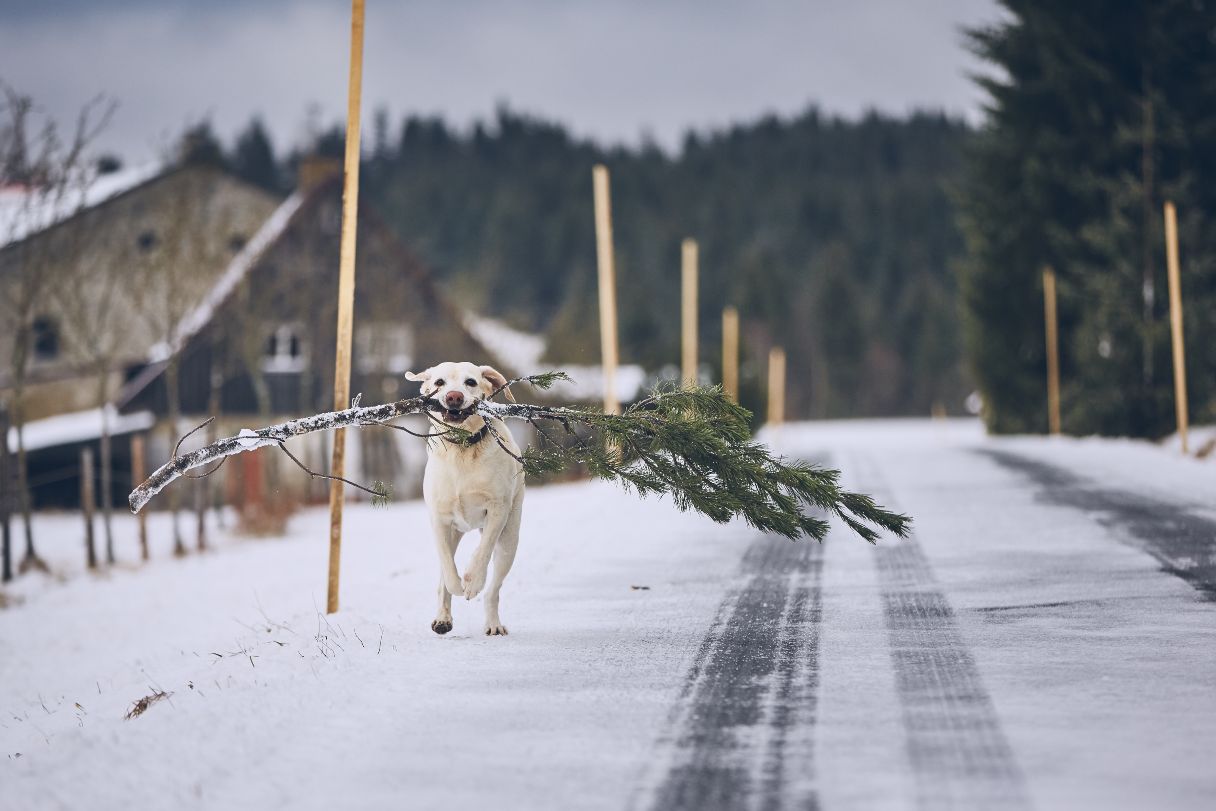When cold weather hits, ice melt is often necessary to accelerate the melting process and prevent people from falling on slippery walkways and roads.
But ice melt can cause problems for our four-legged family members — from mild paw irritation to high toxicity if ingested. Pet parents need to know how to keep their pups safe in cold weather, including protecting them from the potential hazards of ice melts.
1. Ice Melt Can Be Dangerous to Dogs
Most traditional ice melts contain sodium chloride (salt, sometimes called rock salt), potassium chloride, calcium chloride and magnesium chloride, and all of these minerals are toxic to dogs.1 Chlorides can hurt your pet’s paws just by walking through them, and then become more dangerous if your dog ingests them by licking their paws afterward.2
2. Signs Your Dog May Be Hurt or Injured
If your dog licks their paws a couple of times, the risk is much lower than if they consume a large amount of ice melt.1 This is why it’s really important to keep ice melt in a container that your dog can’t get into.
Keep an eye out for symptoms of gastrointestinal upset, sores or neurological signs of toxicity like:
- Irritation on their paws3
- Dehydration1
- Diarrhea1
- Drooling3
- Seizures or tremors1
- Ulcers in the mouth1
- Vomiting1
Ice melt toxicosis often causes hypernatremia, which is a condition that occurs when there is too much sodium in the body. Besides wiping your pet’s paws after they walk around outside in the winter, the first aid for ice melt ingestion is an immediate vet visit. Aggressive treatment may be needed, so it’s important to take your dog to the vet right away if you know they’ve ingested ice melt and you start to notice any symptoms of toxicity.1
Read Related Articles
10 Tips to Keep Your Dog or Cat Safe During Winter
How to Recognize and Prevent Hypothermia in Dogs
3. How to Identify Pet-Safe Ice Melts
There is no truly safe chemical ice melt, but look for ice melts with urea as the primary ingredient. They will likely be labeled non-toxic, pet-friendly or pet-safe, but a quick look at the ingredients list on the back of the package will help you determine whether the ice melt contains chlorides, urea or a proprietary blend.1
Pet-safe ice melts may still aggravate your pet and cause drooling or vomiting, but it is less irritating than chloride-based ice melts.2 Urea is a nitrogen-containing compound that is produced when proteins break down in the body and come out in the urine. There are a few common uses for it, including fertilizer and de-icers.4
Many hardware or home improvement stores that sell ice melt offer pet-safe alternatives. You can also check out pet stores during the winter season to see what your options might be.
4. Alternatives to Chemical Ice Melts
To avoid chemicals altogether, sand, gravel or wood ash are great alternatives. While they don't melt ice, they provide traction on slippery surfaces. Kitty litter is another option — it may clump but still offers traction without the use of chemicals.3
Look for products labeled as pet-safe or non-toxic, with urea as the primary ingredient, as these are less likely to irritate your dog’s paws or cause harm if ingested, unlike those containing chloride compounds, which can be dangerous for pets.2
Paw wax and dog boots are great ways to protect your pup, though some dogs may lick off the wax, which could lead to gastrointestinal issues. To prevent problems, it’s a good idea to wipe your dog’s feet with a damp cloth after walks to remove any ice-melt residue.1
Tip: If your pup has longer fur, regular grooming and trimming during the winter months can help prevent ice, chemicals and salt from getting stuck in their paws.5
CareCredit Credit Card Financing for Pets
Taking good care of your pet's well-being from nose to tail is essential. Make sure to stay up to date on their regular checkups at the vet to help keep your pet happy and healthy for a lifetime of love. You can use your CareCredit credit card for pet care throughout the year for routine veterinary services as well as emergencies and surgeries.* Use our Acceptance Locator to find a veterinarian near you that accepts CareCredit.
CareCredit is there for you and your pet every step of the way; continue your wellness journey by downloading the CareCredit Mobile App to manage your account, find a provider on the go and easily access the Well U blog for more great articles, podcasts and videos.
In addition to pet care, you can also use your CareCredit credit card for dentistry, cosmetic, vision, hearing, health systems, dermatology, pharmacy purchases, spa treatments and so much more within the CareCredit network. How will you invest in your health and wellness next?
Author Bio
Abbie Mood is a freelance writer with more than 15 years of experience. She has worked with clients of all sizes to create compelling content and she has written for the American Kennel Club, Marriott Bonvoy, Women’s Health Online, Headspace and more.







